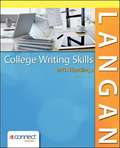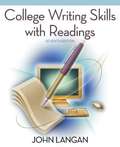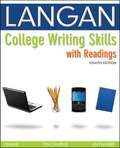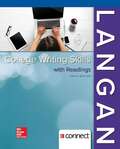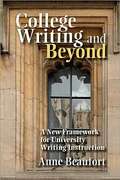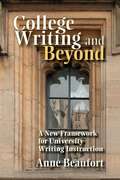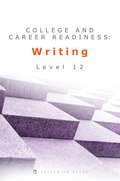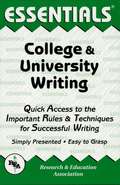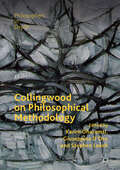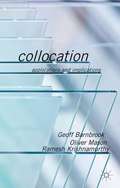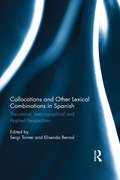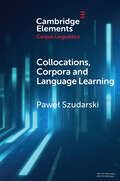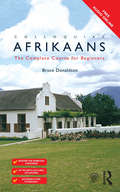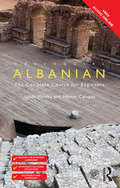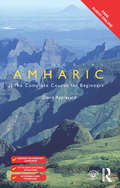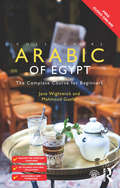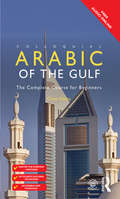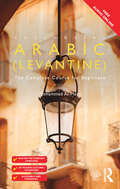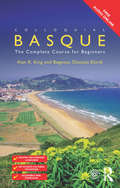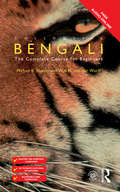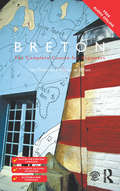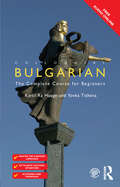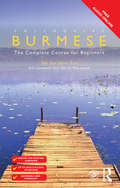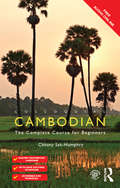- Table View
- List View
College Writing Skills with Readings
by John LanganGrounded in John Langan's Four Bases - unity, coherence, sentence skills, and support - College Writing Skills with Readings employs a unique personalized learning plan to address student deficits in grammar and mechanics and to free instructional time for activities emphasizing writing process and critical thinking. From mastering the traditional five-paragraph essay and its variations to learning about the finer points of grammar and punctuation, College Writing Skills with Readings empowers students to think more deeply about audience and purpose as they write for college and career. This new ninth edition provides a greater balance focus on personal, academic, and workplace writing.
College Writing Skills with Readings (7th edition)
by John LanganJohn Langan's College Writing Skills with Readings, Seventh Edition, focuses on the essay using Langan's renowned clear writing style, as well as his wide range of writing assignments and activities that reinforce the four bases of effective writing: unity, support, coherence, and sentence skills. For the new seventh edition, John Langan has added a variety of fresh elements to his proven approach.
College Writing Skills with Readings (8th edition)
by John LanganThis text offers students a practical guide to becoming better writers. From mastering the traditional five-paragraph essay and its variations to learning about the finer points of grammar and punctuation, the book empowers students to take control of their writing and put it to work for them.
College Writing Skills, With Readings
by John Langan Zoe L. AlbrightCollege Writing Skills with Readings 10e highlights the importance of writing with a purpose by focusing on four bases of writing: unity, support, coherence, and sentence skills. The four bases provide students with clear guidance on how to organize their thoughts, structure their main idea into a thesis, provide supporting evidence to their claim, and revise and edit their work into a well complete, composed essay. College Writing Skills with Readings personalizes and grounds students’ writing experience by placing all of its reading, writing, and essay examples within three key realms - personal, academic, and workplace (PAW) - to emphasize the importance of writing in every facet of life.
College Writing and Beyond
by Anne BeaufortComposition research consistently demonstrates that the social context of writing determines the majority of conventions any writer must observe. Still, most universities organize the required first-year composition course as if there were an intuitive set of general writing "skills" usable across academic and work-world settings. In College Writing and Beyond: A New Framework for University Writing Instruction, Anne Beaufort reports on a longitudinal study comparing one student's experience in FYC, in history, in engineering, and in his post-college writing. Her data illuminate the struggle of college students to transfer what they learn about "general writing" from one context to another. Her findings suggest ultimately not that we must abolish FYC, but that we must go beyond even genre theory in reconceiving it. Accordingly, Beaufort would argue that the FYC course should abandon its hope to teach a sort of general academic discourse, and instead should systematically teach strategies of responding to contextual elements that impinge on the writing situation. Her data urge attention to issues of learning transfer, and to developmentally sound linkages in writing instruction within and across disciplines. Beaufort advocates special attention to discourse community theory, for its power to help students perceive and understand the context of writing.
College Writing and Beyond: A New Framework for University Writing Instruction
by Anne BeaufortComposition research consistently demonstrates that the social context of writing determines the majority of conventions any writer must observe. Still, most universities organize the required first-year composition course as if there were an intuitive set of general writing "skills" usable across academic and work-world settings. In College Writing and Beyond: A New Framework for University Writing Instruction, Anne Beaufort reports on a longitudinal study comparing one student’s experience in FYC, in history, in engineering, and in his post-college writing. Her data illuminate the struggle of college students to transfer what they learn about "general writing" from one context to another. Her findings suggest ultimately not that we must abolish FYC, but that we must go beyond even genre theory in reconceiving it. Accordingly, Beaufort would argue that the FYC course should abandon its hope to teach a sort of general academic discourse, and instead should systematically teach strategies of responding to contextual elements that impinge on the writing situation. Her data urge attention to issues of learning transfer, and to developmentally sound linkages in writing instruction within and across disciplines. Beaufort advocates special attention to discourse community theory, for its power to help students perceive and understand the context of writing.
College and Career Readiness: Writing Level 12
by Douglas Grudzina Priscilla Baker<p>College and Career Readiness: Writing gives you everything you need to prepare your 12th-grade students to produce the types of writing they'll be asked for in college and beyond. <p>This powerful program is more than merely aligned with the Common Core State Standards — it was built from the ground up with the Standards at the core. Every lesson supports and guides students through the process of crafting exceptional pieces in one of four genres: Personal, Informative, Persuasive, and Research writing.</p>
College and University Writing Essentials
by Robert TruscottREA's Essentials provide quick and easy access to critical information in a variety of different fields, ranging from the most basic to the most advanced. As its name implies, these concise, comprehensive study guides summarize the essentials of the field covered. Essentials are helpful when preparing for exams, doing homework and will remain a lasting reference source for students, teachers, and professionals. College and University Writing covers reading skills, the active reading process, basic composition, narration in the first or third person, writing about literature, images, metaphors and symbols, themes in literature, research assignments, and creative writing.
Collingwood on Philosophical Methodology (Philosophers in Depth)
by Stephen Leach Karim Dharamsi Giuseppina D'OroThis book discusses Collingwood's conception of the role and character of philosophical analysis. It explores questions, such as, is there anything distinctive about the activity of philosophizing? If so, what distinguishes philosophy from other forms of inquiry? What is the relation between philosophy and science and between philosophy and history? For much of the twentieth century, philosophers philosophized with little self-awareness; Collingwood was exceptional in the attention he paid to the activity of philosophizing. This book will be of interest both to those who are interested in Collingwood’s philosophy and, more generally, to all who are interested in the question ‘what is philosophy?’
Collocation: Applications and Implications
by Geoff Barnbrook Oliver Mason Ramesh KrishnamurthyThis book presents a comprehensive description of collocation, covering both the theoretical and practical background and the implications and applications of the concept as language model and analytical tool. It provides a definitive survey of currently available techniques and a detailed description of their implementation.
Collocations and other lexical combinations in Spanish: Theoretical, lexicographical and applied perspectives (Routledge Studies In Hispanic And Lusophone Linguistics Ser.)
by Sergi Torner Castells Elisenda Bernal GallenThis edited collection presents the state of the art in research related to lexical combinations and their restrictions in Spanish from a variety of theoretical approaches, ranging from Explanatory Combinatorial Lexicology to Distributed Morphology and Generative Lexicon Theory. Section 1 offers a presentation of the main theoretical and descriptive approaches to collocation. Section 2 explores collocation from the point of view of its lexicographical representation, while Section 3 offers a pedagogical perspective. Section 4 surveys current research on collocation in Catalan, Galician and Basque. Collocations and other lexical combinations in Spanish will be of interest to students of Hispanic linguistics.
Collocations, Corpora and Language Learning (Elements in Corpus Linguistics)
by Paweł SzudarskiThis Element provides a systematic overview and synthesis of corpus-based research into collocations focusing on the learning and use of collocations by second language (L2) users. Underlining the importance of collocation as a key notion within the field of corpus linguistics, the text offers a state-of-the-art account of the main findings related to the applications of corpora and corpus-based measures for defining, identifying and analysing collocations as related to second language acquisition. Emphasising the quality of L2 collocation research, the Element illustrates key methodological issues to be considered when conducting this type of corpus analysis. It also discusses examples of pertinent research questions and points to representative studies treated as models of good practice. Aiming at researchers both new and experienced, the Element also points to avenues for future work and shows the relevance of corpus-based analysis for improving the process of learning and teaching of L2 collocations.
Colloquial Afrikaans: The Complete Course for Beginners (Colloquial Ser. #2)
by Bruce DonaldsonColloquial Afrikaans provides a step-by-step course in Afrikaans as it is written and spoken in South Africa and Namibia today. Combining a user-friendly approach with a thorough treatment of the language, it equips learners with the essential skills needed to communicate confidently and effectively in Afrikaans in a broad range of situations. No prior knowledge of the language is required. Key features include: • progressive coverage of speaking, listening, reading and writing skills • structured, jargon-free explanations of grammar • an extensive range of focused and stimulating exercises • realistic and entertaining dialogues covering a broad variety of scenarios • useful vocabulary lists throughout the text • additional resources available at the back of the book, including a full answer key, a grammar summary and bilingual glossaries Balanced, comprehensive and rewarding, Colloquial Afrikaans will be an indispensable resource both for independent learners and students taking courses in Afrikaans. Audio material to accompany the course is available to download free in MP3 format from www.routledge.com/cw/colloquials. Recorded by native speakers, the audio material features the dialogues and texts from the book and will help develop your listening and pronunciation skills.
Colloquial Albanian: The Complete Course for Beginners (Colloquial Series)
by Linda Mëniku Héctor CamposColloquial Albanian: The Complete Course for Beginners has been carefully developed by an experienced teacher to provide a step-by-step course to Albanian as it is written and spoken today. Combining a clear, practical and accessible style with a methodical and thorough treatment of the language, it equips learners with the essential skills needed to communicate confidently and effectively in Albanian in a broad range of situations. No prior knowledge of the language is required. Colloquial Albanian is exceptional; each unit presents a wealth of grammatical points that are reinforced with a wide range of exercises for regular practice. A full answer key, a grammar summary, bilingual glossaries and English translations of dialogues can be found at the back as well as useful vocabulary lists throughout. Key features include: A clear, user-friendly format designed to help learners progressively build up their speaking, listening, reading and writing skills Jargon-free, succinct and clearly structured explanations of grammar An extensive range of focused and dynamic supportive exercises Realistic and entertaining dialogues covering a broad variety of narrative situations Helpful cultural points explaining the customs and features of life in Albania An overview of the sounds and alphabet of Albanian Balanced, comprehensive and rewarding, Colloquial Albanian is an indispensable resource both for independent learners and students taking courses in Albanian. Audio material to accompany the course is available to download free in MP3 format from www.routledge.com/cw/colloquials. Recorded by native speakers, the audio material features the dialogues and texts from the book and will help develop your listening and pronunciation skills.
Colloquial Amharic: A Complete Language Course (Colloquial Ser.)
by David AppleyardColloquial Amharic: The Complete Course for Beginners has been carefully developed by an experienced teacher to provide a step-by-step course to Amharic as it is written and spoken today. Combining a clear, practical and accessible style with a methodical and thorough treatment of the language, it equips learners with the essential skills needed to communicate confidently and effectively in Amharic in a broad range of situations. No prior knowledge of the language is required. Colloquial Amharic is exceptional; each unit presents a wealth of grammatical points that are reinforced with a wide range of exercises for regular practice. A full answer key, a grammar summary, bilingual glossaries and English translations of dialogues can be found at the back as well as useful vocabulary lists throughout. Key features include: A clear, user-friendly format designed to help learners progressively build up their speaking, listening, reading and writing skills Jargon-free, succinct and clearly structured explanations of grammar An extensive range of focused and dynamic supportive exercises Realistic and entertaining dialogues covering a broad variety of narrative situations Helpful cultural points explaining the customs and features of life in Ethiopia. An overview of the sounds of Amharic Balanced, comprehensive and rewarding, Colloquial Amharic is an indispensable resource both for independent learners and students taking courses in Amharic. Audio material to accompany the course is available to download free in MP3 format from www.routledge.com/cw/colloquials. Recorded by native speakers, the audio material features the dialogues and texts from the book and will help develop your listening and pronunciation skills. Additional information on writing the Amharic script can also be found here.
Colloquial Arabic of Egypt: The Complete Course for Beginners (Colloquial Ser.)
by Jane Wightwick Mahmoud GaafarColloquial Arabic of Egypt provides a step-by-step course in spoken Egyptian Arabic – the most widely understood dialect in the Arab world. Combining a user-friendly approach with a thorough treatment of the language, it equips learners with the essential skills needed to communicate confidently and effectively in Egyptian Arabic in a broad range of situations. No prior knowledge of the language is required. Key features include: Arabic in romanization form throughout, with optional Arabic script supplements emphasis on modern conversational language with clear pronunciation guidance progressive introduction to the Arabic alphabet to aid familiarity with simple labels and signs grammar section and bilingual glossaries for easy reference stimulating exercises with lively illustrations new e-resources at www.routledge.com/cw/colloquialsoffering supplementary materials for teachers and learners, including extra activities (and answers), vocabulary lists and cultural information, ideas for group activities linked to each unit in the course, listing of the complete Arabic alphabet, notes comparing Egyptian and Standard Arabic and downloadable additional audio tracks. Balanced, comprehensive and rewarding, this new and revised edition of Colloquial Arabic of Egypt offers an indispensable resource both for independent learners and for students taking courses in Egyptian Arabic. By the end of this course, you will be at Level B1 of the Common European Framework for Languages and at the Intermediate-Mid on the ACTFL proficiency scales. Audio material to accompany the course is available to download free in MP3 format from www.routledge.com/cw/colloquials. Recorded by native speakers, the audio material features the dialogues and texts from the book and will help develop your listening and pronunciation skills.
Colloquial Arabic of the Gulf (Colloquial Ser.)
by Clive HolesThis new edition of Colloquial Arabic of the Gulf has been revised and updated to make learning this variety of Arabic easier and more enjoyable than ever before. Specially written by an expert for self-study and classroom use, the course offers you a step-by-step approach to spoken Arabic of the Gulf, together with an introduction to reading signs, business cards, advertisements and other realia. No prior knowledge of the language is required. Each unit presents numerous grammatical points that are reinforced with a wide range of exercises for regular practice. A full answer key can be found at the back as well as useful vocabulary summaries throughout. Features new to this edition include: a ‘Cultural Point’ section in each unit on important aspects of Gulf culture, society and history, with photographs and realia a ‘Reading Arabic’ section in each unit, plus a special appendix on the Arabic script comprehensive glossaries, both English-Arabic and Arabic-English, containing all the words in the book extra notes on the dialects of Oman. By the end of this rewarding course you will be able to communicate confidently and effectively in Arabic in a broad range of situations. Audio material to accompany the course is available to download free in MP3 format from www.routledge.com/cw/colloquials. Recorded by native speakers, the audio material features the dialogues and texts from the book and will help develop your listening and pronunciation skills. .
Colloquial Arabic: The Complete Course for Beginners (Colloquial Series)
by Mohammad Al-MasriColloquial Arabic (Levantine) provides a step-by-step course in Levantine Arabic as it is used today. Combining a user-friendly approach with a thorough treatment of the language, it equips learners with the essential skills needed to communicate confidently and effectively in Levantine Arabic in a broad range of situations. No prior knowledge of the language is required. Key features include: progressive coverage of speaking, listening, reading and writing skills structured, jargon-free explanations of grammar an extensive range of focused and stimulating exercises realistic and entertaining dialogues covering a broad variety of scenarios useful vocabulary lists throughout the text additional resources available at the back of the book, including a full answer key and bilingual glossaries. Balanced, comprehensive and rewarding, Colloquial Arabic (Levantine) is an indispensable resource both for independent learners and students taking courses in Levantine Arabic. Colloquials are now supported by FREE AUDIO available online. All audio tracks referenced within the text are free to stream or download from www.routledge.com/cw/colloquials. Recorded by native speakers, the audio complements the book and will help enhance learners’ listening and speaking skills. By the end of this course, you will be at Level B1 of the Common European Framework for Languages and at the Intermediate-Low on the ACTFL proficiency scales.
Colloquial Basque: A Complete Language Course (Colloquial Ser.)
by Begotxu Olaizola Elordi Alan R. KingColloquial Basque: The Complete Course for Beginners has been carefully developed by an experienced teacher to provide a step-by-step course to Basque as it is written and spoken today. Combining a clear, practical and accessible style with a methodical and thorough treatment of the language, it equips learners with the essential skills needed to communicate confidently and effectively in Basque in a broad range of situations. No prior knowledge of the language is required. Colloquial Basque is exceptional; each unit presents a wealth of grammatical points that are reinforced with a wide range of exercises for regular practice. A full answer key, a grammar summary, bilingual glossaries and English translations of dialogues can be found at the back as well as useful vocabulary lists throughout. Key features include: A clear, user-friendly format designed to help learners progressively build up their speaking, listening, reading and writing skills Jargon-free, succinct and clearly structured explanations of grammar An extensive range of focused and dynamic supportive exercises Realistic and entertaining dialogues covering a broad variety of narrative situations Helpful cultural points explaining the customs and features of life in n the Basque countryAn overview of the sounds of Basque Balanced, comprehensive and rewarding, Colloquial Basque is an indispensable resource both for independent learners and students taking courses in Basque. Audio material to accompany the course is available to download free in MP3 format from www.routledge.com/cw/colloquials. Recorded by native speakers, the audio material features the dialogues and texts from the book and will help develop your listening and pronunciation skills.
Colloquial Bengali (Colloquial Ser.)
by Mithun B. Nasrin W.A.M Van Der WurffColloquial Bengali provides a step-by-step course in Bengali as it is written and spoken today. Combining a user-friendly approach with a thorough treatment of the language, it equips learners with the essential skills needed to communicate confidently and effectively in Bengali in a broad range of situations. No prior knowledge of the language is required. Key features include: • progressive coverage of speaking, listening, reading and writing skills • structured, jargon-free explanations of grammar • an extensive range of focused and stimulating exercises • realistic and entertaining dialogues covering a broad variety of scenarios • useful vocabulary lists throughout the text • additional resources available at the back of the book, including a full answer key, a grammar summary and bilingual glossaries Balanced, comprehensive and rewarding, Colloquial Bengali will be an indispensable resource both for independent learners and students taking courses in Bengali. Audio material to accompany the course is available to download freely in MP3 format from www.routledge.com/cw/colloquials. Recorded by native speakers, the audio material features the dialogues and texts from the book and will help develop your listening and pronunciation skills.
Colloquial Breton: The Complete Course For Beginners (Colloquial Ser. #5)
by Herve Ar Bihan Ian PressColloquial Breton: The Complete Course for Beginners has been carefully developed by an experienced teacher to provide a step-by-step course to Breton as it is written and spoken today. Combining a clear, practical and accessible style with a methodical and thorough treatment of the language, it equips learners with the essential skills needed to communicate confidently and effectively in Breton in a broad range of situations. No prior knowledge of the language is required. Colloquial Breton is exceptional; each unit presents a wealth of grammatical points that are reinforced with a wide range of exercises for regular practice. A full answer key, a grammar summary, bilingual glossaries and English translations of dialogues can be found at the back as well as useful vocabulary lists throughout. Key features include: A clear, user-friendly format designed to help learners progressively build up their speaking, listening, reading and writing skills Jargon-free, succinct and clearly structured explanations of grammar An extensive range of focused and dynamic supportive exercises Realistic and entertaining dialogues covering a broad variety of narrative situations Helpful cultural points An overview of the sounds of Breton Balanced, comprehensive and rewarding, Colloquial Breton is an indispensable resource both for independent learners and students taking courses in Breton. Audio material to accompany the course is available to download free in MP3 format from www.routledge.com/cw/colloquials. Recorded by native speakers, the audio material features the dialogues and texts from the book and will help develop your listening and pronunciation skills.
Colloquial Bulgarian: The Complete Course For Beginners (Colloquial Ser.)
by Kjetil Ra Hauge Yovka TishevaColloquial Bulgarian: The Complete Course for Beginners has been carefully developed by an experienced teacher to provide a step-by-step course to Bulgarian as it is written and spoken today. Combining a clear, practical and accessible style with a methodical and thorough treatment of the language, it equips learners with the essential skills needed to communicate confidently and effectively in Bulgarian in a broad range of situations. No prior knowledge of the language is required. Colloquial Bulgarian is exceptional; each unit presents a wealth of grammatical points that are reinforced with a wide range of exercises for regular practice. A full answer key, a grammar summary, bilingual glossaries and English translations of dialogues can be found at the back as well as useful vocabulary lists throughout. Key features include: A clear, user-friendly format designed to help learners progressively build up their speaking, listening, reading and writing skills Jargon-free, succinct and clearly structured explanations of grammar An extensive range of focused and dynamic supportive exercises Realistic and entertaining dialogues covering a broad variety of narrative situations Helpful cultural points explaining the customs and features of life in Bulgaria An overview of the sounds and alphabet of Bulgarian Balanced, comprehensive and rewarding, Colloquial Bulgarian is an indispensable resource both for independent learners and students taking courses in Bulgarian. Audio material to accompany the course is available to download freely in MP3 format from www.routledge.com/cw/colloquials. Recorded by native speakers, the audio material features the dialogues and texts from the book and will help develop your listening and pronunciation skills.
Colloquial Burmese: The Complete Course for Beginners (The\colloquial Ser.)
by San San Hnin Tun Patrick McCormickColloquial Burmese provides a step-by-step course in Burmese as it is written and spoken today. Combining a user-friendly approach with a thorough treatment of the language, it equips learners with the essential skills needed to communicate confidently and effectively in Burmese in a broad range of situations. No prior knowledge of the language is required. Key features include: progressive coverage of speaking, listening, reading and writing skills structured, jargon-free explanations of grammar an extensive range of focused and stimulating exercises realistic and entertaining dialogues covering a broad variety of scenarios useful vocabulary lists throughout the text review chapters at intervals throughout the text providing motivational checklists of language points covered an overview of the sounds of Burmese A full answer key and glossary at the back of the book Balanced, comprehensive and rewarding, Colloquial Burmese will be an indispensable resource both for independent learners and for students taking courses in Burmese. Audio material to accompany the course is available to download free in MP3 format from www.routledge.com/cw/colloquials. Recorded by native speakers, the audio material features the dialogues and texts from the book and will help develop your listening and pronunciation skills.
Colloquial Cambodian: The Complete Course for Beginners (New Edition) (Colloquial Series)
by Chhany Sak-HumphryColloquial Cambodian provides a step-by-step course in Cambodian as it is written and spoken today. Colloquial Cambodian has been developed by a linguist and an experienced Cambodian language professor and combines an accessible approach with a thorough treatment of the language, equipping learners with the essential skills needed to communicate confidently and effectively in Cambodian in a broad range of situations. No prior knowledge of the language is required. Key features include: progressive coverage of speaking, listening, reading, and writing skills jargon-free explanations of grammar an extensive range of focused and stimulating exercises realistic and entertaining dialogues covering a broad variety of scenarios coverage of the Cambodian writing script useful vocabulary lists throughout the text additional resources available at the back of the book, including a full answer key, a grammar summary, bilingual glossaries, and translations of dialogues and reading passages. Balanced, comprehensive, and rewarding, Colloquial Cambodian is an indispensable resource both for independent learners and for students taking courses in Cambodian. Accompanying audio material is available for free download from www.routledge.com/9780415524070 in MP3 format. Recorded by native speakers, the audio complements the book and will help enhance learners’ listening and speaking skills.
Colloquial Cantonese: The Complete Course for Beginners (Colloquial Series)
by Gregory James Dana Scott Bourgerie Keith S TongColloquial Cantonese: The Complete Course for Beginners has been carefully developed by an experienced teacher to provide a step-by-step course to Cantonese as it is written and spoken today. Combining a clear, practical and accessible style with a methodical and thorough treatment of the language, it equips learners with the essential skills needed to communicate confidently and effectively in Cantonese in a broad range of situations. No prior knowledge of the language is required. Colloquial Cantonese is exceptional; each unit presents a wealth of grammatical points that are reinforced with a wide range of exercises for regular practice. A full answer key, a grammar summary, bilingual glossaries and English translations of dialogues can be found at the back as well as useful vocabulary lists throughout. Key features include: A clear, user-friendly format designed to help learners progressively build up their speaking, listening, reading and writing skills Jargon-free, succinct and clearly structured explanations of grammar An extensive range of focused and dynamic supportive exercises Realistic and entertaining dialogues covering a broad variety of narrative situations Helpful cultural points explaining the customs and features of life in Hong Kong An overview of the sounds of Cantonese Balanced, comprehensive and rewarding, Colloquial Cantonese is an indispensable resource both for independent learners and students taking courses in Cantonese. Audio material to accompany the course is available to download free in MP3 format from www.routledge.com/cw/colloquials. Recorded by native speakers, the audio material features the dialogues and texts from the book and will help develop your listening and pronunciation skills. .
